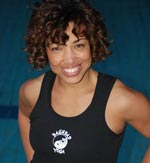Before you dismiss yoga as weird chanting and painful moves that twist your body into a pretzel, hear this: Recent studies show that performing a series of yoga poses and meditating at least three days a week can lower heart disease risk factors including high blood pressure, obesity and high blood sugar. Yoga also clobbers stress, builds muscles, relieves menopausal symptoms and soothes chronic back pain.
Though yoga is becoming more popular in our community—Russell Simmons and Halle Berry are faithful fans—some people still have misconceptions that could cost them potential health benefits. Real Health asked Atlanta-based yoga instructor Michelle Spencer to help us bust the myths, give you the 411 on different types of yoga and offer tips on how to get started.
THE MYTHS:
- Yoga conflicts with my religion: Yoga is not a religion; it’s a philosophy practiced by people from such different religious denominations as Christianity, Buddhism, Judaism and Hinduism. “Yoga means the union of the body, mind and spirit,” says Spencer. “You can use it to empower your Christianity because it opens up your mind and heart. Think of yoga as a body prayer.”
- You have to be super-flexible to do yoga: You may have seen yoga pros posing with their ankles behind their necks, but those moves represent only a small part of the practice. “Being flexible is not the point,” Spencer says. “So what if you can’t touch your toes? Start with your knees. Remember, yoga is a practice; each time you do it, you get better.”
- Yoga is only for women or young people: “Thank goodness this one is not true!” Spencer says. “I teach men, older people and even soldiers who have lost limbs.”
- Yoga isn’t a true workout: When your triceps are burning in downward dog and your legs are quivering in Warrior 1, you’ll know this one is a myth! “Anytime you are moving, you are creating body heat, and with yoga you are breathing deeper and opening yourself up, which is bound to increase your metabolism,” she states. Note: A half-hour of fast-paced Vinyasa can burn 231 calories. Not bad.
SOME POPULAR YOGA TYPES:
- Hatha: The goal in Hatha is to balance between positive and negative energies (sun/ha, and moon/tha, in Sanskrit), and the breath-controlled poses help you achieve that balance through your inner physical and mental strengths.
- Vinyasa: Meaning “breathing and movement,” Vinyasa is a principle of Ashtanga yoga that focuses on internal cleansing. All movements are accompanied by the Ujjayi (“victorious”) breathing, which consists of evenly paced and steady inhalations and exhalations (flow).
- Power: Modified (and Westernized) version of the Indian Ashtanga yoga, which focuses on self-discipline and flexibility. Because poses in this practice are held longer, stamina, concentration and overall strength improve. But note: the muscle-relaxing heated rooms it’s often practiced in won’t protect you from some intense first-timer soreness.
- Bikrim (hot yoga): Consists of selected poses in a heated room, usually kept between 95 and 100 degrees. The heat relaxes the muscles, increasing flexibility and range of motion while keeping injuries at bay. The added bonus is toxin release through all the sweating you’ll be doing—just be sure to stay hydrated and bring a towel to the often lengthy class.
GETTING STARTED:
“Yoga is a process and a great journey towards health, so it doesn’t matter which type you perform,” Spencer assures. “Twice a week is a great way to begin, even if for ten minutes in the morning.”
Taking classes: Classes are good for beginners and for those who need to spot-check their form, but they can be expensive—usually $15-20 per class at a studio. Our tip: Buy a package of 10-20 sessions; they are usually discounted.
If you have a gym membership, take advantage of the yoga classes they offer—most classes are included as part of your monthly fee. Finally, community centers like the YMCA offer inexpensive classes.
Find a class or instructor in your area at blackyogateacher.com.
Do it yourself: For those who might not be comfortable practicing with other people or cannot afford classes or find classes in their area, practicing at home is a wonderful alternative. Just make sure you buy a mat, which can be purchased at discount stores like T.J. Maxx, Ross and Marshalls for less than $15.
DVDs:
- Beginner: Yoga for Beginners(Starz Entertainment, $14.98)
- Intermediate/Advanced: Vinyassa Flow Yoga Session II ith Seane Corn (Gaiam, $20.00)
- Children: Make it a family affair with YogaKids 2: ABCs for Ages 3-6(Gaiam, $15.00)
- Stress: Stress Relief Yoga For Beginners(Gaiam, $15.00)
Websites:
- iyogalife.com: Learn a new pose, find a class and learn how to incorporate yoga into your everyday life.
- yogajournal.com: The San Francisco-based magazine’s website deals with a range of topics including new routines, green living and homeopathic remedies.
Podcasts: These digital lessons are free—just download them onto your iPod.

Michelle Spencer is a registered yoga teacher and a major in the United States Army. She is also the author of the upcoming book Baghdad Yoga. Learn more about Spencer at baghdadyoga.com.






Comments
Comments